VO2max (or maximal oxygen consumption) is one of the key factors in exercise physiology. VO2 max lies at the crossroads between cardiovascular health and endurance capacity in elite sports. Whether you’re looking to optimize your well-being or your sporting performance, this comprehensive guide is your gateway to understanding everything there is to know about this crucial parameter.
The Complete Guide to VO2max
- 1 The Complete Guide to VO2max
- 2 Introduction to Maximum Oxygen Consumption
- 3 Expressing and Measuring VO2 max
- 4 How to calculate VO2max? 2 Formulas
- 5 Maximum Oxygen Consumption and Sports Performance
- 5.1 Best VO2max in Endurance Sports
- 5.2 Fractional Utilisation of VO2max
- 5.3 VO2 differences between men and women
- 5.4 Vo2 max in Cycling & Running: What’s the difference?
- 5.5 Cycling VO2 max table for men (Age)
- 5.6 Cycling VO2 max table for women (Age)
- 5.7 VO2 max table by sport for men
- 5.8 VO2 max table by sport discipline for women
- 5.9 Top athletes and their VO2max
- 5.10 Kilian Jornet’s VO2max
- 5.11 Kristian Blummenfelt and his VO2max
- 5.12 Vo2max by Eliud Kipchoge
- 5.13 VO2max by David Gaudu
- 5.14 Other Men’s Vo2max Record Values
- 5.15 The best VO2max for women
- 6 VO2 max and its Influences (age, health, limitations, environment, etc.)
- 7 Vo2max in Animals
- 8 How to improve your Vo2max
- 9 Conclusion and overview
- 10 FAQ VO2max (Maximum Oxygen Consumption)
- 11 Scientific References

Introduction to Maximum Oxygen Consumption
VO2max, or maximum oxygen consumption, is much more than just a number. It’s a key indicator of your cardiorespiratory capacity and a reflection of the health of your various bioenergetic systems.
Whether you’re an athlete looking to improve your performance or a person looking to improve your health, understanding the role of your VO2max and how to optimize it is essential.
What is VO2max? Definition
VO2max expresses the maximum amount of oxygen your body can use during intense effort. The higher your VO2max, the healthier your cardiovascular system. High maximum oxygen consumption is also a prerequisite if you want to perform at a high level in endurance sports.
To understand the ins and outs of VO2max, let’s explore oxygen’s journey through the body.
Oxygen’s journey through your body
First, your respiratory system brings oxygen into your body through your lungs. Then, your red blood cells (which are filled with hemoglobin) carry this oxygen into the bloodstream. The blood is propelled by your beating heart.

When oxygenated blood reaches the capillaries, the oxygen separates from the hemoglobin and passes into the tissues. Oxygen is said to diffuse from the blood to the muscles or vital organs.
Once in the cells, oxygen is used by the mitochondria. Mitochondria are the descendants of bacteria that enable us to use oxygen and electron carriers (proteins, carbohydrates & lipids) to recycle our ATP. ATP, or adenosine triphosphate, is the human body’s energy currency.
The greater the intensity of physical effort, the faster your body needs to recycle ATP. Vo2max therefore expresses the body’s integrated capacity to absorb, transport and use oxygen.
Origin and evolution History of the VO2max concept
The story of maximum oxygen consumption began 100 years ago, in 1923. That’s when Hill and Lupton described a plateau in a human’s maximum oxygen consumption. Since then, this factor has become a key concept in sports physiology.
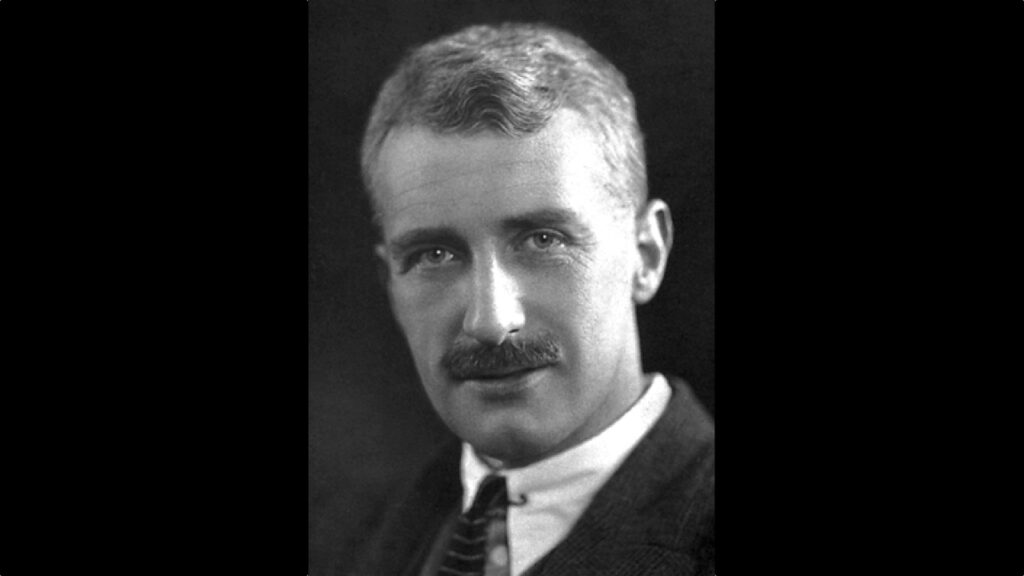
VO2max was long used as a means of prescribing training. At the time, % VO2max was used to describe different intensities of effort. This approach has since been rectified: training recommendations are now based on intensity domains (moderate, high, severe). Physiological benchmarks such as lactate thresholds or ventilatory thresholds can also be used.
Now that we know a little more about VO2 max, let’s see how it can be expressed, measured and calculated.
Expressing and Measuring VO2 max
This chapter will be a little more technical than the others. You need to use the right terms if you want to understand how VO2max works and how it’s measured.
In what unit is Maximum Oxygen Consumption expressed?
As VO2max seeks to define oxygen consumption per unit of time, it can be expressed in two different ways.
An “absolute” unit can be used to express oxygen consumption per unit of time. This is liters of oxygen per minute, abbreviated L/min.
We can also use a “relative” unit, i.e. in relation to body weight. In this case, VO2 max is expressed in millilitres per kilogram per minute, or mL/kg/min.

If you sometimes see a dot above the V in “VO2max”, this means that the volume is expressed per unit of time.
The slow (or kinetic) component of VO2
To understand VO2max, it’s worth looking at the notion of VO2 kinetics. VO2 kinetics describe how oxygen consumption evolves over time at different intensities.
In the moderate range, at constant intensity, oxygen consumption (VO2) reaches a plateau after around 3 minutes of effort. This plateau is then maintained over time.
In the high range, beyond Zone 2 and Threshold #1, the slow component of VO2 appears after 3 minutes of effort. However, this “rebound” also stabilizes after a short latency period.

In the severe range, the loss of movement efficiency, ventilatory demand and pronounced accumulation of by-products such as inorganic phosphates (Pi) generate a slow component that can no longer stabilize.
When does VO2max (Power & MAS) appear?
Contrary to popular belief, VO2max is not associated with a measure of power (cycling) or with a pace/speed or MAS (running). Maximum oxygen consumption simply occurs during prolonged effort in the severe range.
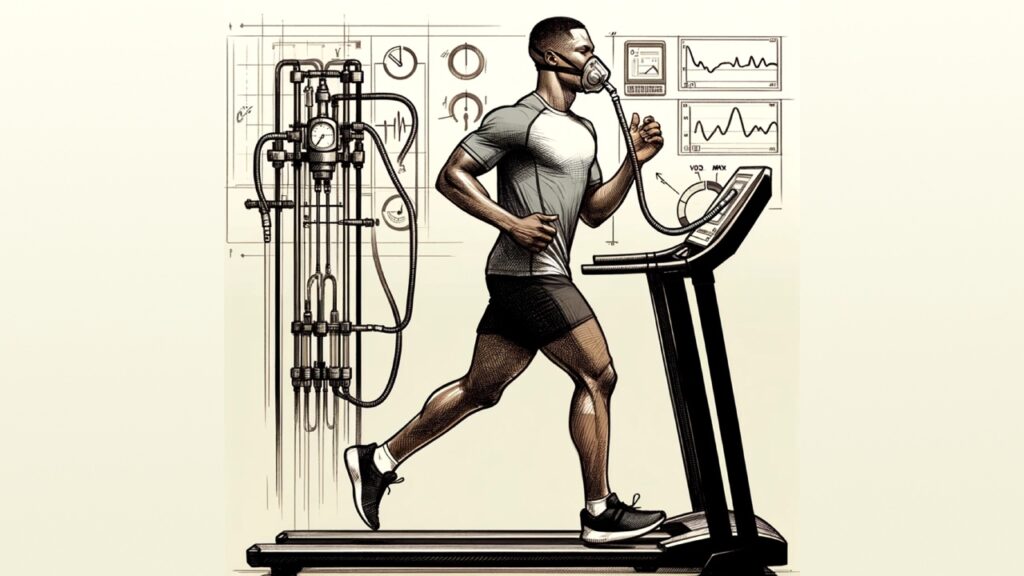
There’s a linear relationship between effort intensity and oxygen consumption. In other words, the more intense the effort, the more oxygen the body consumes. This enables the body to maintain its homeostasis, or internal equilibrium.
Up to Threshold #2 (called FTP, Critical Speed, or Anaerobic Threshold by some), oxygen intake is sufficient to meet needs. But beyond Threshold #2, as oxygen consumption continues to rise, the supply is already at its maximum.

It can therefore be said that VO2max only occurs in the severe domain. The lower limit of this physiological range is Threshold #2. So, rather than associating VO2max with a fixed intensity, we should say that “VO2max occurs above the power/speed associated with Threshold #2“.
The higher the effort intensity/farther from Threshold #2, the faster VO2max will occur. The concept of W’ (“double v prime”) in the Critical Power Model illustrates this notion.
Protocol and Criteria for Measuring VO2 max
The current “gold standard” for determining maximum oxygen consumption is established by the ACSM. The criteria are as follows:
Test Protocol
- An incremental cardiorespiratory test of 6 to 12 minutes total duration
- Stages of 3 minutes (or more)
- A modality that employs more than 50% of the body’s total muscle mass
Exhaustion criteria
- A VO2 plateau is reached despite an increase in intensity,
- A plateau in heart rate (FCmax) is reached despite an increase in intensity,
- Blood lactate concentration exceeds 8.0 mmol/L,
- Perception of exertion exceeds 17 (on Borg’s 6-20 scale), and
- peak ventilatory exchange ratio exceeds 1.10.
It’s important to note that the majority of these standards are highly questioned. The debate continues to rage around the validity of this protocol and the associated criteria. Find out more here.
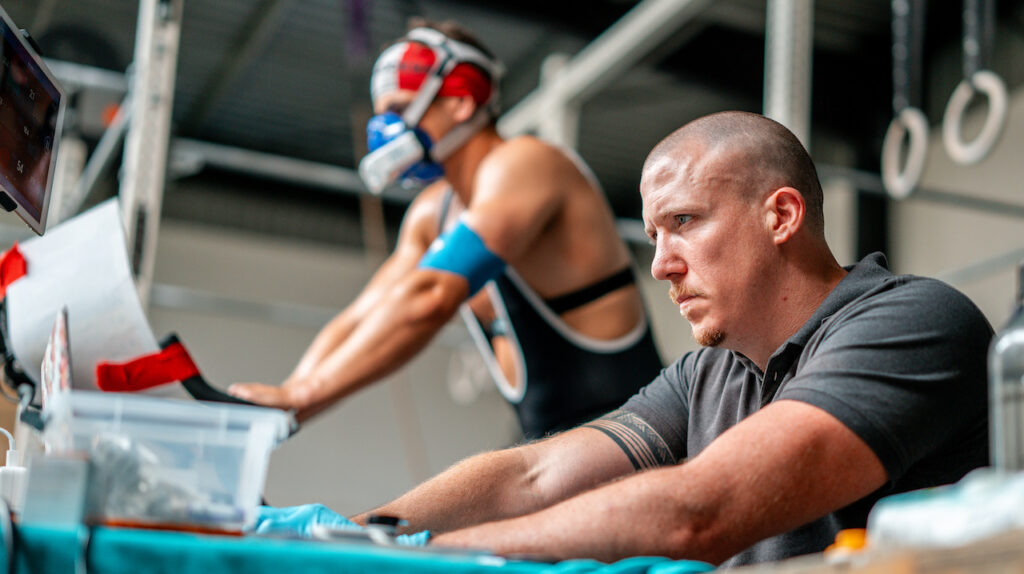
VO2max or VO2peak?
Another indicator linked to maximum oxygen consumption is VO2 peak or peak oxygen consumption. VO2 peak is the observable value obtained during a physical effort session, whether incremental or not. This measurement may be equal to or lower than the VO2 max measured on an incremental test described above.
How to calculate VO2max? 2 Formulas
Even before Archibald Hill defined the concept of VO2 max, oxygen transport in the body had been modeled using Fick’s principle:
VO2 = Q X (CaO2-CvO2),
Where Q represents cardiac output, CaO2 arterial oxygen content, and CvO2 venous O2 content.
Today, we also use another formula based on the work of Peter Wagner,
VO2 = DM X (PcapO2 – PmitO2),
Where DM represents diffusion capacity, PcapO2 the O2 pressure in the capillaries and PmitO2 the O2 pressure in the mitochondria (estimated at zero). This highlights the fact that there is a “functional oxygen reserve” that the muscle cannot consume, even when VO2max is expressed during exercise.
Calculating VO2max from MAS (Maximal Aerobic Speed)
As explained earlier in this guide, VO2max is an oxygen consumption value that appears during prolonged effort in the severe range.

MAS (or maximum aerobic speed) is simply the speed reached on an incremental test (Vaméval, Léger, Léger-Boucher), or the speed maintained on a continuous test (Cooper, Demi-Cooper, Astrand). It therefore represents a “score” and is in no way a physiological value.
It is therefore irrelevant to calculate VO2max from a value such as MAS.
And even if we could, why bother?
VO2max Garmin & Apple Watch – How reliable is VO2 max?
Smartwatches such as the Garmin, Apple Watch or Polar now offer VO2max estimates based on training data.
During my physiological profiling, I’ve already tested people who had an estimate (from their connected watch) very close to the value measured during profiling.
That said, as with any estimate, these calculations should be treated with caution.

The calculation of maximum oxygen consumption by Smart watches will invariably be influenced by the structure and content of your workouts. For example, if you do the vast majority of your training at high intensity, this may overestimate your VO2max.
Smartwatches continue to innovate to improve their algorithms and calculations. And with the advent of Big Data and artificial intelligence, these formulas will become increasingly accurate.
However, it’s always important to remember that a VO2max calculated by a watch or doesn’t take into account important individual factors such as economy of movement and each person’s metabolic profile.
Maximum Oxygen Consumption and Sports Performance
For a long time, VO2max was regarded as a key factor in endurance performance. Today, we understand that maximum oxygen consumption illustrates the “ceiling” of aerobic capacity, or simply the size of the engine.

However, other factors such as economy of movement and VO2max utilization faction, as well as mitochondrial capacity, are the main determinants of endurance performance.
In my experience, a high VO2max is essential for any athlete wishing to maximize work capacity, recovery and overall performance.
Best VO2max in Endurance Sports
Without exception, the best endurance athletes have a very high maximum oxygen consumption. That said, different physical characteristics are required for each sporting discipline.
In a sport like rowing, men can express very high absolute VO2max, in excess of 7 liters of oxygen consumed per minute. The large muscle mass involved explains these record values.
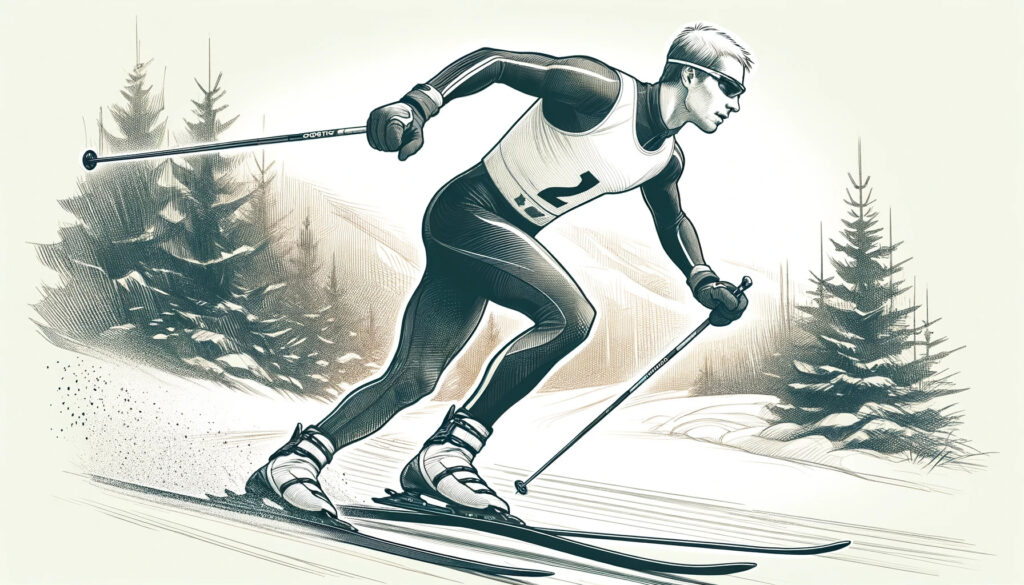
In women’s cross-country skiing and rowing, maximum absolute values of 5 L/min have been measured in elite female competitors.
Cross-country skiing also has the highest relative VO2max values. Over 85 ml/kg/min for men and over 70 ml/kg/min for women. Record values measured in this sport to date are 96 ml/kg/min for men and 80 ml/kg/min for women.
That said, there appears to be an inverse relationship between maximum oxygen consumption and economy (% VO2max) in a stable metabolic state (below Lactate Threshold #2). In other words, the higher the VO2max, the lower the economy, or cost of effort at threshold #2, in relative terms.
Fractional Utilisation of VO2max
This implies that the relationship between maximum consumption and economy must be taken into account according to the type of effort in which you wish to perform.
If an athlete is looking to maximize performance over short periods of effort (<20 minutes), VO2max is to be favoured above all else. On the other hand, if you’re looking to maximize performance over very long durations, as in long-distance triathlon, the fraction of VO2max used at Threshold #2 becomes more important.
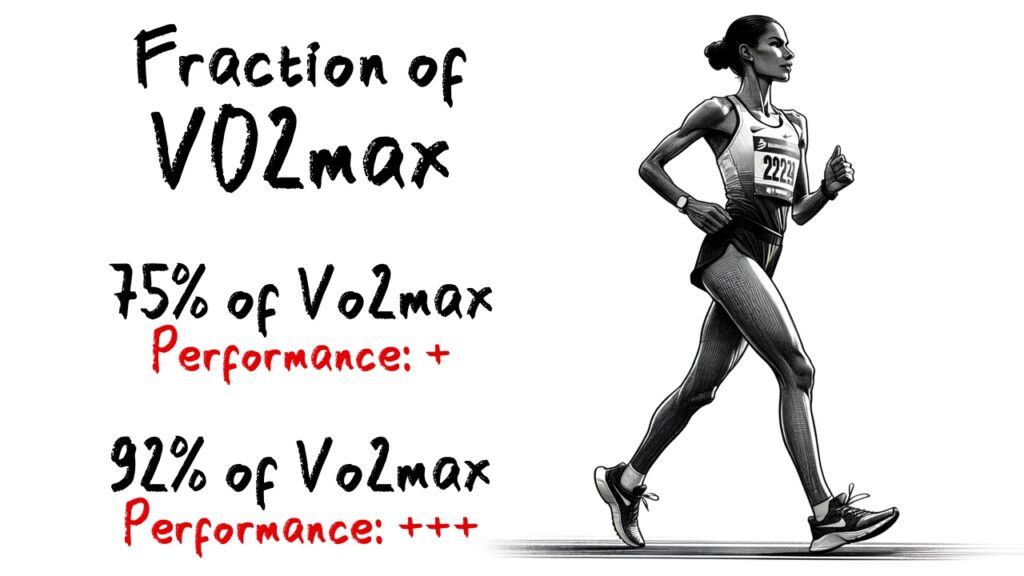
That said, these considerations apply mainly to those who have already maximized their athletic and endurance development over many years.
VO2 differences between men and women
The differences in VO2max observed between men and women are mainly explained by the following factors:
- Different body mass
- higher percentage of body fat in women
- Lower haemoglobin content in women.
This results in differences of around 40-50% in absolute VO2max values and 15-20% in relative values.

Vo2 max in Cycling & Running: What’s the difference?
It’s important to note that different modalities (cycling, running, rowing) will give different VO2 max measurements during an exercise test. This is largely due to the fact that the muscle mass involved varies according to the sporting activity. The greater the muscle mass involved, the higher the maximum oxygen consumption measured.
That said, specialists in certain disciplines such as kayaking are able to generate VO2max with their upper body in excess of 85% of their running VO2max. And this despite the lower muscle mass involved.
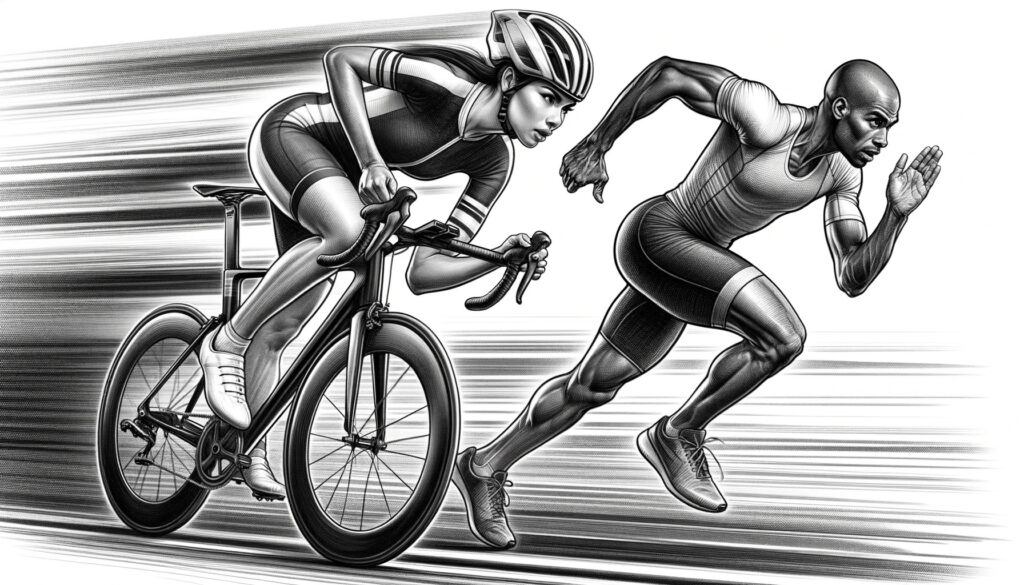
Cycling VO2 max table for men (Age)
The VO2max tables below (men and women) are taken from Astrand’s work in 1960. All VO2 max values are expressed in relative units (ml/kg/min).
This table shows VO2max values for cycling for men of all ages, from 13 to over 60. We can see, for example, that an average VO2max for a 30-year-old man is around 40 ml/kg/min. For a 17-year-old teenager, an excellent VO2max would be above 51 ml/kg/min. A low VO2max for a 55-year-old man would be below 31 ml/kg/min.
| Age | Very Low | Low | Reasonabe | Good | Excellent | Superior |
|---|---|---|---|---|---|---|
| 13-19 | Less than 35.0 | 35.0-38.3 | 38.4-45.1 | 45.2-50.9 | 51.0-55.9 | More than 55.9 |
| 20-29 | Less than 33.0 | 33.0-36.4 | 36.5-42.4 | 42.5-46.4 | 46.5-52.4 | More than 52.4 |
| 30-39 | Less than 31.5 | 31.5-35.4 | 35.5-40.9 | 41.0-44.9 | 45.0-49.4 | More than 49.4 |
| 40-49 | Less than 30.2 | 30.2-33.5 | 33.6-38.9 | 39.0-43.7 | 43.8-48.0 | More than 48.0 |
| 50-59 | Less than 26.1 | 26.1-30.9 | 31.0-35.7 | 35.8-40.9 | 41.0-45.3 | More than 45.3 |
| 60+ | Less than 20.5 | 20.5-26.0 | 26.1-32.2 | 32.3-36.4 | 36.5-44.2 | More than 44.2 |
Cycling VO2 max table for women (Age)
Relative Vo2max values for cycling women of all ages are shown in the following table.
As an example, a good VO2max for a 40-year-old woman is above 29 ml/kg/min. A very low VO2max for an 18-year-old would be below 31 ml/kg/min. For a 55-year-old woman, a VO2 max of over 36 ml/kg/min would be equivalent to an elite level. For a woman of the same age, a low VO2max would be below 20 ml/kg/min.
| Age | Very Low | Low | Reasonable | Good | Excellent | Superior |
|---|---|---|---|---|---|---|
| 13-19 | Less than 25.0 | 25.0 – 30.9 | 31.0 – 34.9 | 35.0 – 38.9 | 39.0 – 41.9 | Above 41.9 |
| 20-29 | Less than 23.6 | 23.6 – 28.9 | 29.0 – 32.9 | 33.0 – 36.9 | 37.0 – 41.0 | Above 41.0 |
| 30-39 | Less than 22.8 | 22.8 – 26.9 | 27.0 – 31.4 | 31.5 – 35.6 | 35.7 – 40.0 | Above 40.0 |
| 40-49 | Less than 21.0 | 21.0 – 24.4 | 24.5 – 28.9 | 29.0 – 32.8 | 32.9 – 36.9 | Above 36.9 |
| 50-59 | Less than 20.2 | 20.2 – 22.7 | 22.8 – 26.9 | 27.0 – 31.4 | 31.5 – 35.7 | Above 35.7 |
| 60+ | Less than 17.5 | 17.5 – 20.1 | 20.2 – 24.4 | 24.5 – 30.2 | 30.3 – 31.4 | Above 31.4 |
VO2 max table by sport for men
In this table you will find representative ranges of VO2max values for male athletes by age and sport.
| Sport | Age | Lower | Upper |
|---|---|---|---|
| Cross-country skiing | 20-28 | 65 | 94 |
| Athletics (Running) | 18-39 | 60 | 85 |
| Cycling | 18-26 | 62 | 74 |
| Speed Skating | 18-24 | 56 | 73 |
| Rowing | 20-35 | 60 | 72 |
| Swimming | 10-25 | 50 | 70 |
| Alpine Skiing | 18-30 | 57 | 68 |
| Canoe Kayak | 22-28 | 55 | 67 |
| Wrestling | 20-30 | 52 | 65 |
| Soccer | 22-28 | 54 | 64 |
| Ski jumping | 18-24 | 58 | 63 |
| Ice Hockey | 10-30 | 50 | 63 |
| Racquetball | 20-35 | 55 | 62 |
| Polo | 20-40 | 50 | 60 |
| Basketball | 18-30 | 40 | 60 |
| Gymnastics | 18-22 | 52 | 58 |
| Baseball and softball | 18-32 | 48 | 56 |
| Athletics (Discus Throw) | 22-30 | 42 | 55 |
| Orienteering | 20-60 | 47 | 53 |
| Weightlifting | 20-30 | 38 | 52 |

VO2 max table by sport discipline for women
In this table you will find representative ranges of VO2max values for female athletes by age and sport.
| Sport | Age | Lower | Upper |
|---|---|---|---|
| Cross-country skiing | 20-28 | 60 | 75 |
| Athletics (Running) | 18-39 | 50 | 75 |
| Rowing | 20-35 | 58 | 65 |
| Football | 22-28 | 50 | 60 |
| Racquetball | 20-35 | 50 | 60 |
| Orienteering | 20-60 | 46 | 60 |
| Basketball | 18-30 | 43 | 60 |
| Swimming | 10-25 | 40 | 60 |
| Baseball and softball | 18-32 | 52 | 57 |
| Cycling | 18-26 | 47 | 57 |
| Volleyball | 18-22 | 40 | 56 |
| Alpine Skiing | 18-30 | 50 | 55 |
| Speed skating | 18-24 | 44 | 55 |
| Canoe-Kayak | 22-28 | 48 | 52 |
| Gymnastics | 18-22 | 36 | 50 |
Top athletes and their VO2max
In this section we explore the VO2 max levels achieved by the best and best-known endurance athletes.
Kilian Jornet’s VO2max
Kilian Jornet is a world-renowned Spanish athlete, best known for his exploits in trail running, ski mountaineering and mountaineering. On his website, Kilian mentions a VO2max of 92 ml/kg/min at a body weight of 58-59kg, i.e. almost 5.5 L/min in absolute Vo2.
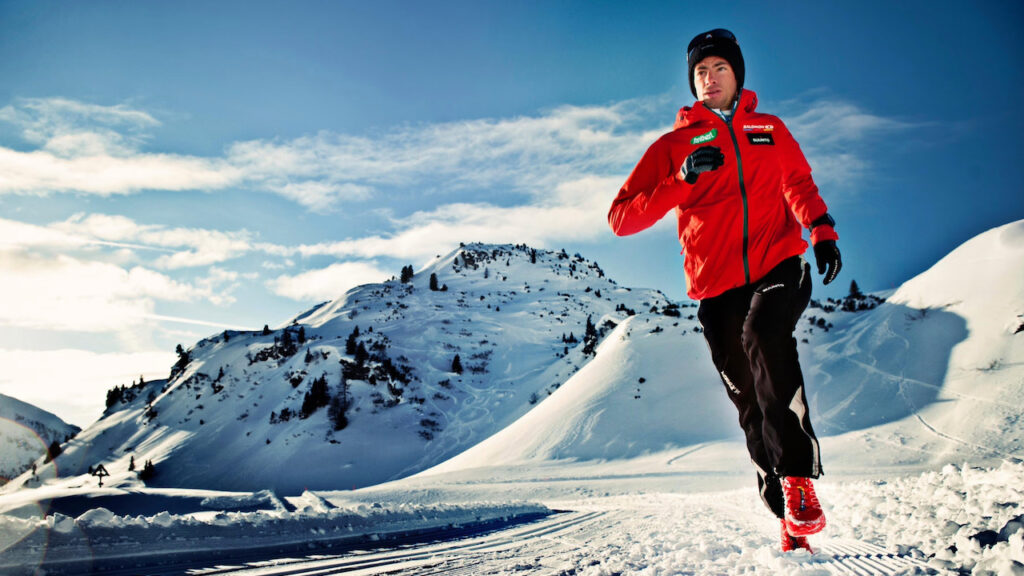
Kristian Blummenfelt and his VO2max
Kristian Blummenfelt is a Norwegian professional triathlete, known for his remarkable performances in the world of triathlon. He reports a vo2max of 87 ml/kg/min or 6.6 L/min (at 76kg body weight).
Vo2max by Eliud Kipchoge
Eliud Kipchoge is a Kenyan long-distance runner, widely regarded as one of the greatest marathoners of all time. He has an estimated Vo2max of around 70 ml/kg/min.

VO2max by David Gaudu
David Gaudu is a French professional cyclist, known for his climbing skills in road races. At the age of 18, his Vo2max was measured at 92 ml/kg/min.
Other Men’s Vo2max Record Values
| Name | Sport | VO2max (ml/kg/min) |
|---|---|---|
| Oskar Svendsen | Cycling | 97.5 |
| Bjørn Dæhlie | Cross-country skiing | 96.0 |
| Espen Harald Bjerke | Cross-country skiing | 96.0 |
| Greg LeMond | Cycling | 92.5 |
| Miguel Indurain | Cycling | 88.0 |
| Chris Froome | Cycling | 84.6 |
| Lance Armstrong | Cycling | 84.0 |
The best VO2max for women
| Name | Sport | VO2max (ml/kg/min) |
|---|---|---|
| Joan Benoit | Long-distance running | 78.6 |
| Bente Skari | Cross-country skiing | 76.6 |
| Flavia Oliveira | Cycling | 76.0 |
| Rosa Mota | Long-distance running | 67.2 |
VO2 max and its Influences (age, health, limitations, environment, etc.)
In this chapter we’ll explore the different elements that influence VO2max. You’ll understand the different factors that can limit VO2max and performance, the effect of age on Vo2max and the impact of the environment on maximum oxygen consumption. You’ll also see the impact VO2max can have on health.
Influence of Age on VO2Max
From the age of 30 onwards, VO2max decreases by around 1% per year. However, this decline is attenuated in those who continue to engage in frequent training. This supports the hypothesis that aging and exercise can have beneficial effects on aerobic capacity.
So if you do nothing, you may be in the 95th percentile of VO2max for your age at 30 (in the best of times), but you’ll just be able to climb the stairs slowly at 80.
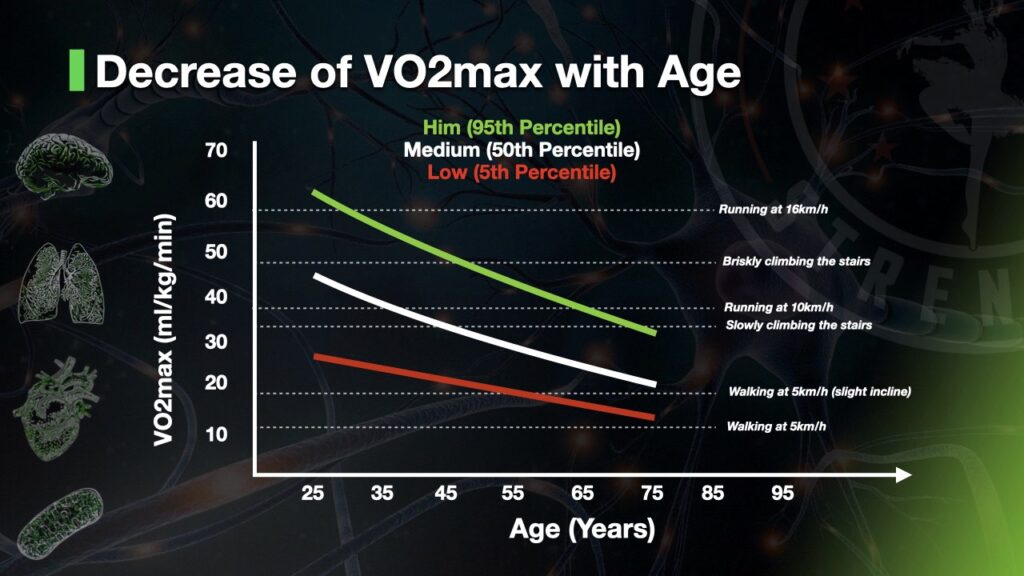
Influence of VO2max on Health and Longevity
Cardiorespiratory fitness was inversely related to long-term mortality, and no maximum threshold of benefit was found. Excellent aerobic fitness (VO2max) was linked to increased survival, and showed benefits in the elderly and those with hypertension.
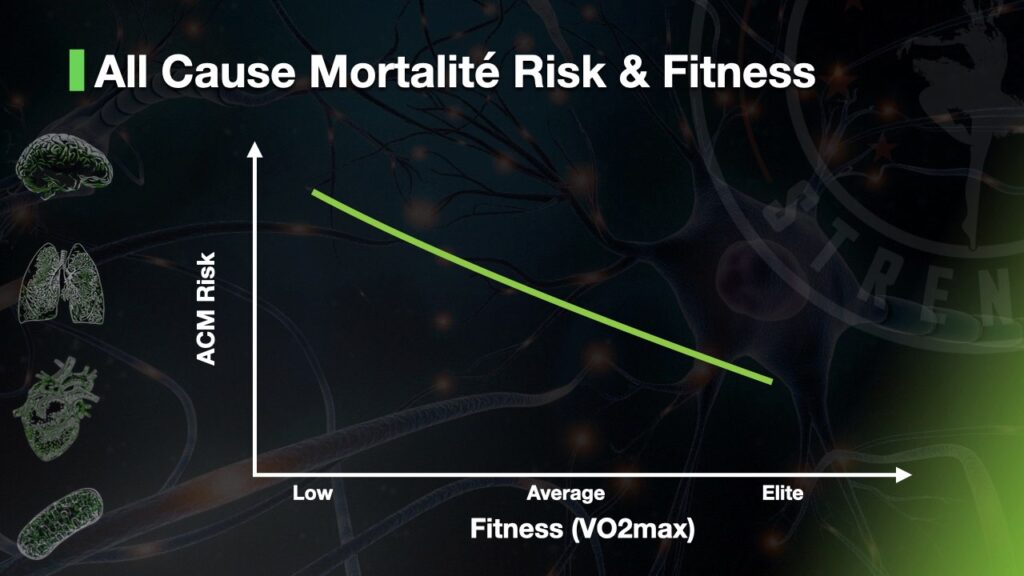
In concrete terms, a person in the 25th percentile (low VO2max) has a 50% greater risk of all-cause mortality than someone in the 95th percentile.
We also know that people who have suffered cardiac arrest often have a VO2max lower than 14 ml/kg/min. This can be improved with appropriate training. This gives these people a greater chance of survival and a better quality of life.
Cardiorespiratory fitness is a modifiable factor influencing long-term mortality. Healthcare professionals should encourage their patients to achieve and maintain a high level of physical fitness, whatever their age or level of health.
Limitation of Maximum Oxygen Consumption (Physiological Factors)
There are 4 factors that can limit maximum oxygen consumption (VO2 max):
- Alveolar perfusion
- Cardiac output
- Oxygen transport
- Oxygen utilization
Let’s go through these parameters one by one.
Limitation of the Respiratory System
For a non-elite at sea level, lung function is more than sufficient to saturate arterial blood with oxygen (>95% SpO2). But in certain situations, the respiratory system can become a limiting factor in VO2max.
Elite athletes can express cardiac outputs 40% higher than untrained individuals (40 L/min vs. 25 L/min). This considerably reduces the transit time of red blood cells in the pulmonary capillaries. This is why Dempsey et al. have demonstrated that elite athletes are more susceptible to arterial desaturation during intense exertion.
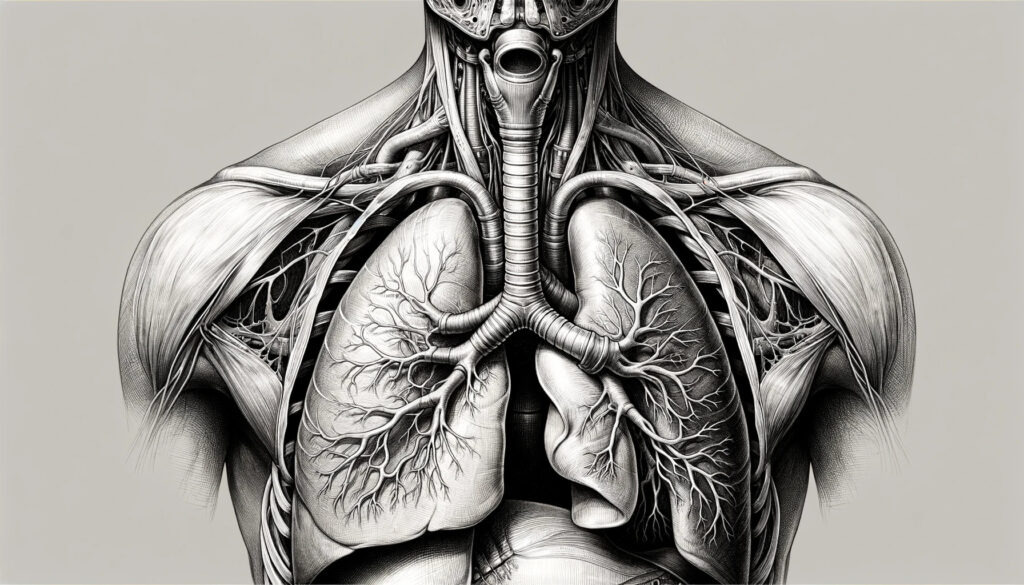
We also know that physical exertion at altitude (especially between 3000m and 5000m) is subject to pulmonary limitations.
Finally, asthma and other COPD sufferers experience a reduction in arterial O2 pressure, which weakens the oxygen cascade described at the start of this guide.
Cardiac Output Limitation
It is currently estimated that 70 to 85% of VO2max limitation can be attributed to cardiac output. More specifically, the measurement of systolic ejection volume has a considerable impact on VO2max.
We know that elite athletes have a “bigger” heart, i.e. one that can propel more blood with each beat. This explains the difference in heart rate described above, despite the fact that maximum heart rate changes very little between trained athletes and sedentary people.
Oxygen transport limitation
Endurance training and (unfortunately) doping (EPO) increase the oxygen-carrying capacity of the blood. Through the re-infusion of over-oxygenated blood, an increase in VO2 max of the order of 4-9% has been measured. The link between increased hemoglobin and maximum oxygen consumption is well documented.
Muscle limitation (Oxygen uptake)

The respiratory capacity of the muscle (via the mitochondria) does not directly limit VO2max. We do know, however, that there is a strong relationship between capillary density and maximal oxygen consumption.
Influence of Altitude on VO2max
Low-pressure (hypobaric) environments put a lot of stress on the body, especially the respiratory system.
Physical effort at altitude is difficult because less O2 is available. The percentage of O2 in the air remains the same (21%), but there is less O2 per volume of air.

Above 1524m, VO2 begins to decrease, by around 3% per 300m of elevation (GRAPH).
Above 6000m, atmospheric O2 pressure is so low that the VO2 of two individuals will be virtually identical, even though it is very different at sea level.
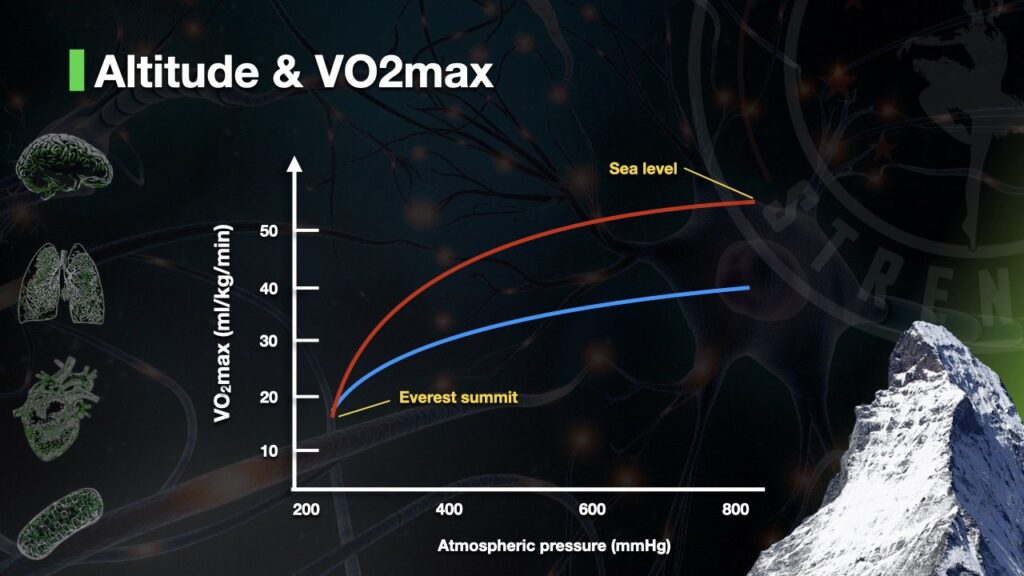
As described earlier, elite endurance athletes are more susceptible to gas exchange limitations in hypoxic conditions.
The cost of effort (oxygen consumption) is the same at altitude as at sea level, but the perception of effort is higher. This is because the solicited VO2max percentage is greater.

Vo2max in Animals
It’s interesting to explore the animal kingdom and compare other VO2max values.
Laboratory rats have a VO2max similar to that of well-trained endurance athletes (in relative terms), with values of 60 to 75 ml/kg/min.
Thoroughbred horses can express VO2max values in excess of 170 ml/kg/min. They approach 200 ml/kg/min after a high-intensity training program.
Alaskan huskies have been measured at over 240 ml/kg/min.

Finally, when a hummingbird flaps its wings 80 times per minute, its VO2 is greater than 650 ml/kg/min. By manipulating air density, the hummingbird was pushed to 1090 ml/kg/min in a 1999 study. These performances are possible thanks to several factors:
- The bird’s lung diffusion capacity is estimated at 8x that of mammals of its size
- its heart is 2x larger than usual for its size
- capillary density is 6x greater than average
- Mitochondrial volume is 35% (4-9% in humans)
How to improve your Vo2max
There are many ways to increase your vo2max. All solutions require an active approach to be effective.
Increase your Level of Physical Activity
An increase in vigorous physical activity is associated with an increase in VO2max. It is therefore important to increase your level (and intensity) of training to improve your maximum oxygen utilization capacity.
For people in poor physical condition, even strength training is known to increase VO2max.
Practice Zone 2 Training
Low-intensity training improves mitochondrial capacity and therefore VO2max. The greater your mitochondrial capacity, the greater your “factory” for using oxygen.
These workouts also enlarge the heart’s left ventricle. This increases cardiac output. Cardiac output is highly correlated with VO2max.

To develop your fundamental endurance and associated qualities, aim for 2 to 4 sessions per week, each lasting 20 to 60 minutes. Respect a Zone 2 intensity, or an RPE of 2-3/10 for the duration of these efforts.
Integrate HIIT, MAS or Vo2max workouts
HIIT stands for High Intensity Interval Training. This type of training is also commonly known as split training, vo2max training or MAS training.
These workouts stimulate the cardivascular system and allow you to spend time at a high percentage (>90-95%) of VO2max. This directly increases your VO2max.
These workouts come in a variety of forms. These include
- Continuous VO2max intervals (2-5x 4-8 minutes), RPE8-10
- Tabata-type split intervals (20/10, 30/10, etc…)
- Decreasing intervals (4′ + rest 2′, then 3′ + rest 1:30, etc.)
These workouts are very effective, but they need to be integrated intelligently into an overall plan. I recommend 1 to 2 workouts of this type per week at most. And not all year round.
“A high VO2 Max is a function of a high heart rate and high heart stroke volume. Training to improve VO2 Max therefore requires intervals that demand both high heart rate and pressure
on the left ventricle of the heart to provide a stimulus for adaptation. The ideal intervals will allow the athlete to spend time at a high percentage of VO2 Max. While this can be achieved by short, Tabata style intervals, that type of training does not provide the greatest time with high stroke volume (due to the short interval, and then short recovery which reduces pressure in the left ventricle). A better solution to interval training aimed at improving VO2 Max is intervals of 2 to 4 minutes in duration.
Most athletes can progress over a focused block of VO2 Max training to a total time at intensity of 15 to 20 minutes. The end-goal session would be 5-6 times 3′ intervals at RPE 8-9 with an equivalent period of rest of 3′ in between intervals. The objective of the session is to perform each interval at a high intensity, to recovery full in between repetitions, and then maintain the same effort across all the intervals in the set. This is a very challenging session and will take time to build towards. A useful progression would be to start with short intervals and build up the duration of the intervals. For example, the progression could be:
1) 3 x [7 x(30″ hard / 15″ easy)] / 3′ easy.
2) 3′ hard / 2′ easy, (10 x 30″ hard / 20″ easy).
3) High Intensity, Decreasing Interval Training (HIDIT) of 3′ hard / 2′ easy / 2′ hard / 1’20” easy / 1′ hard / 40″ easy / 45″ hard / 30″ easy /30″ hard / 20″ easy.
4) 5 x (2′ hard / 2′ easy).
5) 5 x (3′ hard / 3′ easy).
In general, the short-term improvement from VO2 Max intervals will start to plateau after 10-12 sessions at which time the athlete may choose to focus on a different stimulus. If the athlete performs 2-3 VO2 Max sessions in a week, then a focused block of VO2 Max training may last 4-5 weeks. In this time the athlete could work through the progression above aiming to do each session twice.
More experienced athletes may not need to work through the progression and could start immediately with 3′ intervals. Athletes who are not following a block periodisation plan could work through the progression with one session a week and build up to the optimal intervals in a few months.”

Thanks to Daniel Rowland for his contribution!
Daniel is an endurance sport coach in Switzerland.
You can follow him on Twitter and read his substack.
Integrating Sprint Interval Training (SIT)
SIT is an extremely intense type of training, consisting of supra-maximal (“all out”) efforts lasting from 6 to 30 seconds. These efforts are generally repeated for a total effective duration of 90 to 180 seconds per session. The rest between each repetition is long, generally 5 to 8 times the duration of the work interval.
SIT-type training increases VO2max by targeting peripheral adaptations. In other words, thanks to this training, the muscle is able to extract and use oxygen more efficiently.
This type of training should be incorporated once or twice a week at most, and only for people who can perform this type of supra-maximal effort.
Conclusion and overview
VO2max is a key indicator of both health and sporting performance. I hope this resource will give you all the keys you need to understand this indispensable factor. Whether you’re an amateur athlete, a competitive athlete or a health professional, VO2max has no secrets for you!
FAQ VO2max (Maximum Oxygen Consumption)
As a general rule, men’s VO2 max is between 40 and 50 mL/min/kg, while women’s is between 35 and 45 mL/min/kg. In highly athletic individuals, these values may exceed 70 mL/min/kg for men and 60 mL/min/kg for women.
For a 20-year-old man, a VO2max of 40ml/kg/min is average. A VO2 max of over 52 is elite. For a 20-year-old woman, a VO2max of 25ml/kg/min is low, while a VO2 max of 40 is excellent.
VO2max is the maximum amount of oxygen (measured in milliliters) that your body can absorb, transport and use per minute and per kilogram of body weight during intense effort.
At 30, a VO2max of 35 ml/kg/min is reasonable for a man. To reach an elite level, a value of over 50 is necessary. For a woman of the same age, 28 ml/kg/min is reasonable and over 40 ml/kg/min is elite.
For a 40-year-old man, a VO2max of 37ml/kg/min is average. A VO2 max of over 48 is elite. For a 40-year-old woman, a VO2max of 22ml/kg/min is low, while a VO2 max of 35 is excellent.
Any sporting discipline that recruits a large amount of muscle mass and can be performed continuously is ideal for increasing maximum oxygen consumption. Examples include running, cycling, rowing and cross-country skiing.
At 50, a VO2max of 32 ml/kg/min is reasonable for a man. To reach an elite level, a value of over 45 is required. For a woman of the same age, 24 ml/kg/min is reasonable and over 36 ml/kg/min is elite.
For a 60-year-old man, a VO2max of 30ml/kg/min is reasonable and a VO2 of 42 is excellent. For a 60-year-old woman, 26ml/kg/min VO2 is good, while 34ml/kg/min is excellent.
Increasing VO2max improves cardiovascular health and sports performance. A better VO2max means that our body can absorb, transport and use more oxygen.
There are several strategies for achieving a higher VO2max:
– Increase your level of physical activity
– Fundamental endurance training (Zone 2)
– HIIT or high-intensity interval training
– Sprint Interval Training (SIT) sessions
To test your VO2max, you need to go to a laboratory or contact a specialist who carries out physiological profiling. VO2max can easily be tested on a bike or treadmill using an incremental test protocol.
Smart watches estimate VO2max on the basis of speed, power and heart rate data collected during training sessions.
Several factors contribute to this phenomenon. These include the heart’s diminished capacity to pump a significant amount of blood with each beat as we age, as well as reduced muscle mass, leading to a reduced demand for oxygen in the blood.
The current record is held by Oskar Svendsen, world junior time trial champion in 2012, with a VO2max of 97.5 ml/min/kg and, in the women’s category, marathoner Joan Benoit with a VO2max of 78.6 ml/min/kg.
There are 4 main parameters that influence VO2max:
– Alveolar perfusion
– Cardiac output
– Blood oxygen transport capacity
– Oxygen utilization capacity (mitochondria)
Vingegaard has a VO2 max (maximum oxygen uptake) of 97 ml/kg/min, indicating an exceptionally high cardiorespiratory capacity.
Simply put, the higher your VO2max, the healthier you’ll stay as you age. Consult the VO2max tables in this article to find out the scales for different ages.
Scientific References
Aadahl et al. (2007). Self-reported physical activity compared with maximal oxygen uptake in adults. European Journal of Cardiovascular Prevention & Rehabilitation, 14(3), 422-428. DOI: 10.1097/HJR.0b013e3280128d00
Abe et al. (2013). Resistance training induced increase in VO2max in young and older subjects. European Review of Aging and Physical Activity, 10, 107–116. https://doi.org/10.1007/s11357-012-9384-z
Astrand (1960). Aerobic work capacity in men and women with special reference to age. Acta Physiologica Scandinavica Supplementum, 49(169), 1-92. DOI: Not available.
Bassett Jr. et al. (2000). Limiting factors for maximum oxygen uptake and determinants of endurance performance. Medicine & Science in Sports & Exercise, 32(1), 70-84. DOI: 10.1097/00005768-200001000-00012
Bedford, T. G. et al. (1979). Maximum oxygen consumption of rats and its changes with various experimental procedures. Journal of Applied Physiology, 47(6), 1278-1283. https://doi.org/10.1152/jappl.1979.47.6.1278
Beltz et al. (2016). Graded exercise testing protocols for the determination of VO2max: Historical perspectives, progress, and future considerations. Journal of Sports Medicine, 2016, 3968393. DOI: 10.1155/2016/3968393.
Brendle et al. (2003). Aging and marathon times in an 81-year-old man who competed in 591 marathons. The American Journal of Cardiology, 91(9), 1154-1156. https://doi.org/10.1016/s0002-9149(03)00174-7
Calbet et al. (2015). Limitations to oxygen transport and utilization during sprint exercise in humans: evidence for a functional reserve in muscle O2 diffusing capacity. The Journal of Physiology, 593(20), 4649–4664. https://doi.org/10.1113/JP270408
Chai et al. (1999). Maximum Flight Performance of Hummingbirds: Capacities, Constraints, and Trade‐Offs. The American Naturalist, 153(4). DOI: 10.1086/303179
Colosio et al. (2020). Bioenergetics of the VO2 slow component between exercise intensity domains. Pflügers Archiv – European Journal of Physiology, 472(10), 1447-1456. DOI: 10.1007/s00424-020-02437-7.
Dempsey et al. (2020). Is the healthy respiratory system built just right, overbuilt, or underbuilt to meet the demands imposed by exercise? Journal of Applied Physiology, 129(6), 1235-1256. DOI: 10.1152/japplphysiol.00444.2020
Gledhill et al. (1985). The influence of altered blood volume and oxygen transport capacity on aerobic performance. Exercise and Sport Sciences Reviews, 13, 75-93. DOI: 10.1249/00003677-198500130-00007.
Haugen et al. (2018). New Records in Human Power. International Journal of Sports Physiology and Performance, 13(6), 678-686. DOI: 10.1123/ijspp.2017-0441.
Hill, A. V. et al. (Year). Muscular Exercise, Lactic Acid, and the Supply and Utilization of Oxygen. QJM: An International Journal of Medicine, os-16(62), 135. https://dx.doi.org/10.1093/qjmed/os-16.62.135
Kitaoka, Y. et al. (2011). Effect of training and detraining on monocarboxylate transporter (MCT) 1 and MCT4 in Thoroughbred horses. Experimental Physiology, 96(3), 348-355. https://doi.org/10.1113/expphysiol.2010.055483
Korzeniewski et al. (2019). Pi-induced muscle fatigue leads to near-hyperbolic power-duration dependence. European Journal of Applied Physiology, 119(10), 2201-2213. DOI: 10.1007/s00421-019-04204-8.
Mandsager, K., Harb, S., Cremer, P., Phelan, D., Nissen, S. E., & Jaber, W. (2018). Association of cardiorespiratory fitness with long-term mortality among adults undergoing exercise treadmill testing. JAMA Network Open, 1(6), e183605. doi: 10.1001/jamanetworkopen.2018.3605
Michael et al. (2009). Determinants of Kayak Paddling Performance. Sports Biomechanics, 8(2), 167-179. DOI: 10.1080/14763140902745019.
Millet et al. (2023). The V̇O2max Legacy of Hill and Lupton (1923)—100 Years On. International Journal of Sports Physiology and Performance, 18(11), 1362. https://doi.org/10.1123/ijspp.2023-XXXX
Poole et al. (2017). Measurement of the maximum oxygen uptake V̇o2max: V̇o2peak is no longer acceptable. Journal of Applied Physiology, 122(4), DOI: 10.1152/japplphysiol.01063.2016
Rosenblat et al. (2020). Reply to “Comment on Effect of High-intensity Interval Training Versus Sprint Interval Training on Time-Trial Performance: A Systematic Review and Meta-Analysis”. Sports Medicine, 50(12), 2265-2267. DOI: 10.1007/s40279-020-01353-1
Saltin et al. (1977). Fiber types and metabolic potentials of skeletal muscles in sedentary man and endurance runners. Annals of the New York Academy of Sciences, 301, 3-29. https://doi.org/10.1111/j.1749-6632.1977.tb38182.x
Sandbakk et al. (2018). Sex Differences in World-Record Performance: The Influence of Sport Discipline and Competition Duration. International Journal of Sports Physiology and Performance, 13(1), Article 2. https://doi.org/10.1123/ijspp.2017-0196
Støren et al. (2017). The effect of age on the VO2max response to high-intensity interval training. Medicine and Science in Sports and Exercise, 49(1), 78-85. DOI: 10.1249/MSS.0000000000001070.
Suarez et al. (1998). Oxygen and the Upper Limits To Animal Design And Performance. Journal of Experimental Biology. DOI: 10.1242/jeb.201.8.1065
Van der Zwaard et al. (2021). Under the Hood: Skeletal Muscle Determinants of Endurance Performance. Frontiers in Sports and Active Living. https://doi.org/10.3389/fspor.2021.719434
Webb et al. (2023). The relationship between hemoglobin and VO2max: A systematic review and meta-analysis. PLOS ONE, 18(10), e0292835. DOI: 10.1371/journal.pone.0292835.